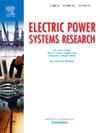Impact of concrete-encased grounding systems on lightning overvoltages in transmission lines
IF 4.2
3区 工程技术
Q2 ENGINEERING, ELECTRICAL & ELECTRONIC
引用次数: 0
Abstract
This paper addresses the influence of concrete on the overvoltages developed in a 138-kV transmission line (TL) subjected to lightning strikes with variable amplitude. This study considers a tower-footing grounding system consisting of four counterpoise conductors, utilizing both bare and concrete-encased electrodes. The harmonic grounding impedance is initially calculated over a frequency range from 100 Hz to 10 MHz. Subsequently, the ground potential rise (GPR) developed by the tower-footing grounding system under lightning currents with adjustable peak values is analyzed. Furthermore, the impulse impedance is computed to model the tower-footing grounding system within the simulated power network. The TL is modeled using the Universal Line Model (ULM), which incorporates frequency-dependent (FD) soil parameters and ground-return parameters calculated via Nakagawa’s equations. Simulations are performed in ATP-EMTP, where the ULM is implemented in MATLAB and incorporated into the model via a PCH file. Finally, the overvoltage waveforms generated for the 138-kV power system subjected to a lightning strike are analyzed for three different values of low-frequency soil resistivity modeled using Alípio-Visacro’s approach: 700, 1500, and 4000 m. The simulation results reveal a substantial reduction in harmonic impedance for the concrete-encased grounding system compared to the bare-electrode configuration. This reduction leads to lower impulse impedance and results in GPR waveforms with significantly reduced peak values when concrete is incorporated into the grounding system. However, in high-resistivity soils, the reduction achieved by the concrete-encased system is limited to approximately 33%. In addition, the overvoltages generated by lightning strikes are lower when the concrete-encased grounding system is used. In contrast, the bare grounding system leads to backflashover events, which do not occur when the concrete-encased grounding system is used.
混凝土接地系统对输电线路雷电过电压的影响
本文研究了混凝土对变幅雷击下138kv输电线路过电压的影响。本研究考虑了一个由四个平衡导体组成的塔式接地系统,利用裸露的和混凝土包裹的电极。谐波接地阻抗的初始计算范围为100hz ~ 10mhz。分析了塔底接地系统在峰值可调雷电流作用下产生的地电位上升。在此基础上,通过脉冲阻抗的计算对模拟电网中的塔基接地系统进行建模。TL采用通用线模型(ULM)建模,该模型结合了频率相关(FD)土壤参数和根据Nakagawa方程计算的地面返回参数。仿真在ATP-EMTP中进行,其中ULM在MATLAB中实现,并通过PCH文件纳入模型。最后,在使用Alípio-Visacro方法建模的三种不同的低频土壤电阻率值(700、1500和4000 Ω m)下,对遭受雷击的138 kv电力系统产生的过电压波形进行了分析。模拟结果显示,与裸电极配置相比,混凝土封装接地系统的谐波阻抗大幅降低。当将混凝土掺入接地系统时,这种减少会导致脉冲阻抗降低,并导致GPR波形的峰值显著降低。然而,在高电阻率土壤中,混凝土包覆系统所实现的减少仅限于约33%。采用混凝土接地系统时,雷击过电压较低。相反,裸接地系统会导致反闪络事件,而采用混凝土接地系统则不会发生反闪络事件。
本文章由计算机程序翻译,如有差异,请以英文原文为准。
求助全文
约1分钟内获得全文
求助全文
来源期刊

Electric Power Systems Research
工程技术-工程:电子与电气
CiteScore
7.50
自引率
17.90%
发文量
963
审稿时长
3.8 months
期刊介绍:
Electric Power Systems Research is an international medium for the publication of original papers concerned with the generation, transmission, distribution and utilization of electrical energy. The journal aims at presenting important results of work in this field, whether in the form of applied research, development of new procedures or components, orginal application of existing knowledge or new designapproaches. The scope of Electric Power Systems Research is broad, encompassing all aspects of electric power systems. The following list of topics is not intended to be exhaustive, but rather to indicate topics that fall within the journal purview.
• Generation techniques ranging from advances in conventional electromechanical methods, through nuclear power generation, to renewable energy generation.
• Transmission, spanning the broad area from UHV (ac and dc) to network operation and protection, line routing and design.
• Substation work: equipment design, protection and control systems.
• Distribution techniques, equipment development, and smart grids.
• The utilization area from energy efficiency to distributed load levelling techniques.
• Systems studies including control techniques, planning, optimization methods, stability, security assessment and insulation coordination.
 求助内容:
求助内容: 应助结果提醒方式:
应助结果提醒方式:


